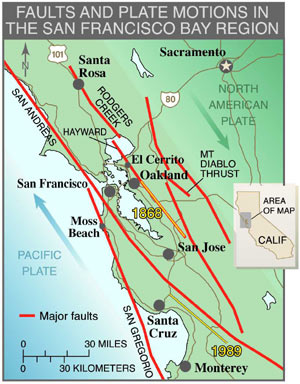1 Answer
Bay Area Earthquake Probabilities
Note: This report has been superseded by a new probability forecast.
Figure 1. Faults and plate motions in the San Francisco Bay Region. Faults in the region, principally the seven faults shown here and characterized in this report, accommodate about 40 mm/yr of mostly strike-slip motion between the Pacific and North American tectonic plates. Yellow lines show the locations of the 1868 M6.8 earthquake on the southern portion of the Hayward Fault and the 1989 M6.9 Loma Prieta earthquake near the San Andreas fault northeast of Monterey Bay.
Earthquakes in the San Francisco Bay Region result from strain energy constantly accumulating across the region because of the northwestward motion of the Pacific Plate relative to the North American Plate (Figure 1 ). The region experienced large and destructive earthquakes in 1838, 1868, 1906, and 1989, and future large earthquakes to relieve this continually accumulating strain are a certainty. For our study we define the SFBR as extending from Healdsburg on the northwest to Salinas on the southeast. It encloses the entire metropolitan area, including its most rapidly expanding urban and suburban areas. We have used the term "major" earthquake as one with M>=6.7 (where M is moment magnitude). As experience from recent earthquakes in Northridge, California (M6.7, 1994, 20 killed, $20B in direct losses) and Kobe, Japan (M6.9, 1995, 5500 killed, $147B in direct losses), earthquakes of this size can have a profound impact on the social and economic fabric of densely urbanized areas.

SEE HERE>>>>http://earthquake.usgs.gov/regional/nca/wg02/index.php
| 13 years ago. Rating: 5 | |

 Hands Across Time
Hands Across Time
 lindilou
lindilou




